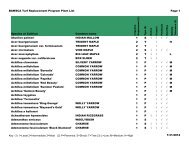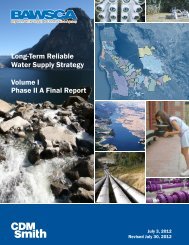SFPUC Wholesale Customer Water Demand Projections ... - BAWSCA
SFPUC Wholesale Customer Water Demand Projections ... - BAWSCA
SFPUC Wholesale Customer Water Demand Projections ... - BAWSCA
Create successful ePaper yourself
Turn your PDF publications into a flip-book with our unique Google optimized e-Paper software.
SECTIONTHREE<br />
Establishing Base - Year Conditions<br />
Section 3 THREE Establishing Base - Year Conditions<br />
3.1 INTRODUCTION<br />
This section describes the development of base-year conditions for the typical <strong>SFPUC</strong> wholesale<br />
customer in the DSS Model as depicted in the portion of Figure 2-1 above the dashed line. The<br />
section explains how available demographic data, customer-billing data, and water use studies<br />
were used to establish base-year conditions for the DSS model and characterize the water use for<br />
each wholesale customer service area; and how these data were reconciled to estimate the<br />
average number of users per account.<br />
Appendix B includes a summary of customer-specific adjustments made in establishing baseyear<br />
conditions and demand forecasting.<br />
3.2 SELECTION OF BASE YEAR<br />
The base year for this study is 2001. The base year serves as the starting year for the water<br />
demand analysis and is used to establish initial conditions of water usage. The year 2001 was<br />
selected over 2002 and 2003 for this study for three reasons:<br />
• 2001 shows less of an effect of the economic recession. The year 2002 shows a dip in water<br />
demand in many areas due to reduction in economic activity. This kind of reduction is<br />
cyclical and demand generally rebounds in better economic times.<br />
• 2001 had relatively “normal” climatic conditions (i.e., it was neither a drought nor an<br />
excessively wet year).<br />
• Records for 2003 were incomplete at the time of the analysis, which was started in mid-2003.<br />
Figures 3-1a, 3-1b, and 3-1c show the water consumption for several <strong>SFPUC</strong> wholesale<br />
customers from 1999 to 2002 that demonstrates the general trend of a dip in the year 2002.<br />
Industrial, commercial, and multi-family water use was affected by the recession, particularly in<br />
Silicon Valley. This dip was most likely due to a loss of jobs, exporting manufacturing overseas,<br />
and reduced business, followed by the loss of workers who lived in apartments and moved out of<br />
the area leaving abnormally high vacancy rates. <strong>Customer</strong>-billing data from 1999 to 2002<br />
indicate that single-family water use was not affected by the recession.<br />
The bold lines in Figures 3-1a, 3-1b and 3-1c indicate a 12-month moving average of the water<br />
use for each wholesale customer graphed. Looking at the 12-month moving average, Figure 3-1a<br />
shows that industrial use in Milpitas, Palo Alto, and Santa Clara started to decline in 2000, with<br />
accelerated decline in 2001, and continued to decline through 2002. Reviewing the 12-month<br />
moving average for commercial use in Milpitas and Palo Alto Figure 3-1b shows a nearly 10<br />
percent decline in 2002 relative to 2001. Figure 3-1c shows similar declines in multi-family<br />
water use during this period in Hayward and Milpitas.<br />
3.3 WATER USE DATA<br />
As discussed in the modeling approach, the DSS models were set up and calibrated using a<br />
method that combines billing data, demographic data, and water use studies to establish the baseyear<br />
model conditions for each wholesale customer service area. This section describes the steps<br />
to get from total water production to end uses.<br />
3-1







